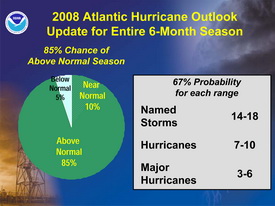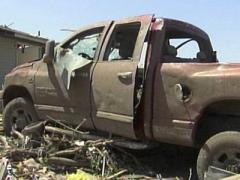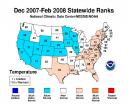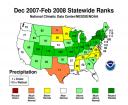
In their August update to hurricane season forecasts, experts at the National Oceanic and Atmospheric Administration (NOAA) have changed their predictions for the season and now expect a greater chance of hurricanes this season. They are now predicting an “above normal” season with 14 to 18 named storms – up from the 12 to 16 they predicted in May.
The forecasters now believe there is an 85 percent chance that this above normal trend will take place (up from 65 percent in May).
“Leading indicators for an above-normal season during 2008 include the continuing multi-decadal signal – atmospheric and oceanic conditions that have spawned increased hurricane activity since 1995 – and the lingering effects of La Niña,” said Gerry Bell, Ph.D. of NOAA’s Climate Prediction Center. “Some of these conditions include reduced wind shear, weaker trade winds, an active West African monsoon system, the winds coming off of Africa and warmer-than-average water in the Atlantic Ocean.”

Thus far in 2008 there have been five named storms and the most active hurricane period – August to October – is just now beginning. Will this prediction hold true? Unfortunateley forecasters have struggled in recent years with their predictions. Last year NOAA predicted 10 hurricanes and only six formed. The year prior, 2006, nine hurricanes were forecasted by NOAA but only five formed. In 2005, the year Hurricane Katrina devastated New Orleans in the worst U.S. natural disaster, the forecasts underestimated storm activity.


 This past weekend a deadly spate of tornadoes struck Oklahoma and Missouri, killing at least 22 people. More than a third of those died in cars despite the fact that vehicles are one of the worst possible places to be when a twister strikes.
This past weekend a deadly spate of tornadoes struck Oklahoma and Missouri, killing at least 22 people. More than a third of those died in cars despite the fact that vehicles are one of the worst possible places to be when a twister strikes. This week NOAA’s National Climatic Data Center announced that from December 2007 to February 2008 temperatures across the United States and the globe were their coolest since 2001. In the contiguous United States, the average winter temperature was 33.2°F which ranks it as the 54th coolest winter since national records began in 1895. Globally, the combined land and ocean surface temperature was the 16th warmest on record for the period.
This week NOAA’s National Climatic Data Center announced that from December 2007 to February 2008 temperatures across the United States and the globe were their coolest since 2001. In the contiguous United States, the average winter temperature was 33.2°F which ranks it as the 54th coolest winter since national records began in 1895. Globally, the combined land and ocean surface temperature was the 16th warmest on record for the period.

